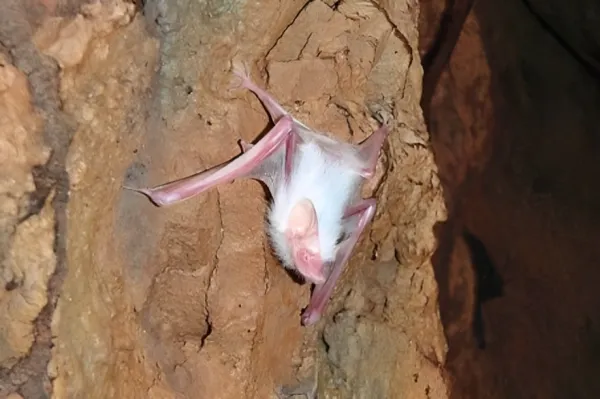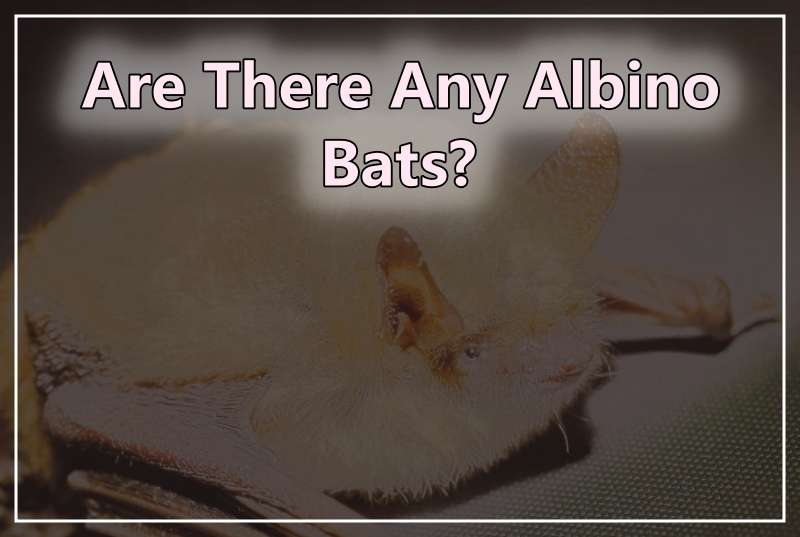Albino bats are rather typical, despite their rarity. Only bats can fly, and they make up most mammals. Albino bats are one of the about 1,300 species of bats today.
Albinism is a hereditary condition that prevents the body from making enough melanin. Melanin gives mammals and other creatures distinctive pigmentation; without it, the animal would have white fur and pink eyes. Albinism occurs in all mammalian species. However, it is uncommon in the wild.
Albino bats are intriguing animals that serve as a valuable reminder of the value of biological diversity. As such, they and their habitats should be safeguarded for the sake of the entire ecosystem.
Albino bats may be uncommon, yet they are still mammals who need our protection since they are mammals nonetheless. In this article, we will discuss the Albino bats. Let’s dive in without further ado.
Are There Any Albino Bats?
Yes, albino bats do exist. Albinism is a genetic disorder that causes an individual to have no melanin in their skin, hair, or eyes. Rare as it may be, bats are not immune to the condition.
Because bats are nocturnal and frequently found in dim settings, spotting their albinism can be challenging. However, if an albino bat is discovered, its fur will be white or very light, its eyes will be pink, and its skin will be ashen.
Although albino bats have been documented, they are unusual in the wild. This is because animals with less pigment have a more challenging time hiding from predators and finding food when they go hungry.
Therefore, albino bats are more common in zoos and aquariums, where they are safe and well-cared for.

Due to their lack of pigmentation, albino bats stand out from the crowd. Its fur and skin are white or very light in hue, often pink to yellow.
Their wings are transparent so that you can see their blood vessels, and they typically have pink or crimson eyes. In general, albino bats stand out visually from their non-albino relatives.
First Discovery of Albino Bats
True albinism, leucism, piebaldism, and hypomelanosis are four conditions that can result from insufficient melanin production.
All forms of melatonin insufficiency can be traced back to inherited or genetic (congenital) anomalies. Many different types of marine mammals, terrestrial mammals, and bats have been observed with these abnormalities worldwide.
In Brazil 1867, 17 species of bats have had their lack of melanin pigmentation confirmed 31 times.
Twenty of the cases were recorded as having albinism, an inherited hypo pigmentary disorder characterized by a total lack of melanin due to the absence of the enzyme tyrosinase.
Resulting in pale skin, white fur or feathers, and red eyes, and eleven as having piebaldism, in which melanin is absent from a portion of the skin and hair follicles due to the absence of melanocytes in that portion of the skin.
The paper details the discovery of two albino specimens of Peropteryx kappleri Peters, 1867, bringing the total number of individual instances of albinism among Brazilian bats to 33.
In addition, this is just the third worldwide report of albinism in the family Emballonuridae and the first for the genus Peropteryx.
The Floresta Nacional de Carajás (FLONA-Carajás) in the Brazilian state of Pará is where the albino bats were spotted. This national park is situated entirely within the Amazon Forest domain.
The FLONA-Carajás is a Conservation Unit for the long-term and varied use of forest resources and scientific study. It spans over 390,000 acres thanks to Decree No. 2,486 from February 2, 1998.
The Ombrophilous Forest is the dominant biome in this area, while there is some variation due to changes in the topography.
The region’s caves are primarily found in these outcrops, and mining has significantly impacted this vital home for some species of bats. Iron ore occurrences interrupt the forest cover and attract considerable investment.
Albino bats were first spotted in 2016 and 2017 at FLONA-Carajás caverns in the municipalities of Parauapebas and Cana dos Carajás, both in the Brazilian state of Pará.
On September 4, 2016, an adult male, P. kappleri, was discovered in cave PESE-0004 for the first time. On October 23, 2017, researchers made their second discovery of a P. kappleri in cave S11D-0007.
The caves included species displayed more than 5 meters from the entrance. The adult male was off by himself, but similarly-colored members of his species surrounded the little one.
Both people were completely albino; one of the hallmarks of the disorder is eye color which becomes a distinctive shade of red.
The few albino bats seen in the wild for less than 30 minutes displayed no behavioral or other observable differences from their non-albino counterparts, despite their different morphology (i.e., color).
Difference between Albino Bats and White Bats
Although white and albino bats may look identical initially, they are separate species. The distinction is as follows:
Albino bats:
Albino bats are highly unusual because of a genetic disorder. Albino bats lack pigmentation due to this disorder and appear with skin, hair, and eyes that are white, red, or pink.
They are more sensitive to light and have worse eyesight than regular bats. The genetic mutation that causes albinism is recessive; therefore, for a bat to be born albino, its mother and father must be carriers of the trait.
White bats:
But not all white bats are albinos. Instead, they have extremely pale or white fur. The white fur on these bats may help them blend into their surroundings and avoid being eaten. Just two of the numerous species of white bats are the Honduran white bat and the ghost bat.
White and albino bats share the same outward appearance but for distinct reasons. Albino bats have white fur because of a genetic abnormality, while white bats have evolved to have white fur. The Other Differences are:
- White bats have white fur or skin, although they may not be albino. Albino bats lack melanin, which gives skin, hair, and eyes color.
- Albino bats have pink or red eyes, whereas white bats may have black eyes.
- Bats with white hair or skin may only have it in some locations, whereas albino bats have decreased or nonexistent pigmentation throughout.
- White bats may have acquired white fur or skin as a camouflage adaptation, although albino bats are exceedingly rare and more susceptible to predators due to their lack of pigmentation.
- Health problems, including visual and hearing impairments, are more common in albino bats than white bats because of their lack of melanin.
- White bats may be less susceptible to sunburn and other skin disorders than their albino counterparts.
- White bats may have an advantage in their native environments, whereas albino bats may have a worse survival rate due to their diminished ability to hide and elude predators.
- Because of their different look from the rest of the bat population, albino bats attract attention, whereas white bats may be less noticeable.
- Due to health issues, albino bats may have shorter lives than non-albino bats, although white bats’ lifespans are likely unaffected.
- White bats might be more prevalent in some regions than others, but albino bats are highly uncommon.
Problems with Albinism in Any Species
1. Disfigurement and abnormal growth of the eyes:
The eye’s iris, retina, eye muscles, and optic nerve benefit from melanin’s presence and developmentally appropriate expression. Abnormal eye development, including focusing and depth perception issues, comes from a lack of melanin.
Because the iris of an albino animal lacks the pigment that usually conceals the color of the retina’s red blood cells, the animal’s eyes appear red.
Albino animals’ eyes may have a pale blue due to factors other than genetics. When albino vertebrates are subjected to bright light, their photoreceptors often die off through apoptosis.
2. Albino animals have less melanin to defend them from the sun.
Melanin shields the skin from harmful UV rays in the sun. Melanosomes filter out the sun’s damaging frequencies while letting the beneficial ones through.
This indicates that unprotected animals may perish from UV rays. Albino persons require the heavy application of sunscreen even when the sky is overcast.
3. Survival disadvantages
Many albino animals are at a greater risk of being discovered by predators and prey because they cannot blend into their surroundings.
Albino animals had a worse chance of surviving in the wild, although it has been found that, in tests where animals had plenty of hiding spots, they were captured at the same rate as their non-albino counterparts.
Furthermore, albino animals may be rejected as mates or even by their own families and communities.
4. Hearing loss and decreased chances of survival
From 800 albino eggs, just 29 reached full maturity, according to studies conducted on medaka fish in a lab setting with no natural predators, an abundant food supply, regulated temperatures, etc.
Albinism is a pigmentation condition that can cause deafness in mice, rats, guinea pigs, and cats.
Some Facts on Albino Bats
- There are almost no albino bats. Less than one percent of bats are thought to be albinos. Albino bats’ fur and skin are white because they do not produce enough of the pigment melanin. Due to their lack of melanin, albino bats have pink or red eyes.
- Because of their inability to hide from predators as well as other bats, albino bats may have a harder time making it in the wild. Albino bats have a greater risk of developing eyesight and hearing impairments, as well as skin disorders like sunburn, due to their lack of melanin.
- Albino bats may be particularly susceptible to climate change because they are unable to maintain a stable internal temperature. Fruit bats, insectivorous bats, and even vampire bats have all been seen to have albinism.
- Due to their status as a genetic outlier, sightings of albino bats in the field are extremely unusual and difficult to anticipate. Albino bats have attracted the attention of scientists and hobbyists alike due to their striking appearance.
- While it’s true that certain albino bats have been maintained in captivity and utilized for educational reasons, everyone should remember that bats are still wild animals that require special care.
Frequently Asked Question
Q1. Do white albino bats exist?
Ans. Yes, Albino White bats exist. These bats are very rare and can be found anywhere. There is no fixed location to find these bats.
Q2. Where do albino bats live?
Ans. Some bats roost in trees, buildings, and other man-made structures rather than caves. Albino bats are extraordinarily unusual and sporadic in the wild; different species of albino bats may inhabit different regions of the planet.
Q3. Do albino bats have red eyes?
Ans. Due to their lack of melanin, albino bats have pink or red eyes.
Q4. How rare are albino bats?
Ans. Only 64 individuals across 38 species and 8 groups have been recorded as entirely albino.
Q5. What are albino bats worth?
Ans. It is important to remember that bats are not pets or commodities, and they should not be bought, sold, or traded.
Q6. How many albino bats are left in the world?
Ans. There are almost no albino bats. Less than one per cent of bats are thought to be albinos. Albino bats’ fur and skin are white because they do not produce enough of the pigment melanin
Q7. Are albino bats dangerous?
Ans. The bat population has a far lower risk of rabies infection than other mammals, at less than one per cent. However, you shouldn’t touch or bother bats, especially if you see one flying around during the day and it looks sick. Bites from bats should be cleansed with soap and water immediately, and medical attention should be sought.
References:
- First record of albinism for the doglike bat, Peropteryx kappleri Peters, 1867 (Chiroptera, Emballonuridae) by subtitle. pen soft
- Acoustical and morphological comparisons between albino and normally-pigmented Jamaican fruit bats (Artibeus jamaicensis) by biozone
- Wikipedia
Also Read:

A writer who studied agriculture. Nature has always drawn me in, and my main goal in writing about it is to discover some of its secrets. You can usually find me reading Bengali and English masterpieces or filling the room with lovely music if I’m not engrossed in nature or anime material. I adore playing the guitar. I’m also that friend of yours who enjoys playing video games.
